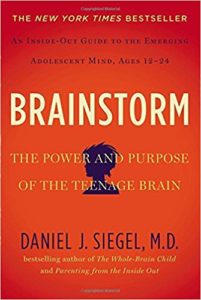Book Review: Brainstorm: The Power and Purpose of the Teenage Brain
 I recently read Brainstorm by Dan Siegel, which offers an in-depth breakdown of how the brain changes during the teenage years, and am excited by the implications it has for adolescents, parents, and practitioners who work with teens.
I recently read Brainstorm by Dan Siegel, which offers an in-depth breakdown of how the brain changes during the teenage years, and am excited by the implications it has for adolescents, parents, and practitioners who work with teens.
Brainstorm provides an in-depth breakdown of the major changes our brains undergo from ages 12 through 24. In taking a brain-based developmental perspective to this book, Siegel is able to debunk the myth of the “moody,” “crazy,” “immature” teen, by framing adolescent behavioral perspectives within the context of the formative brain changes occurring during this time. The core message of the book is that parents need to work to be present with their adolescent children, and work to be accepting of the changes their children are experiencing. When parents can embrace rather than resist the changes their adolescents experience, families are able to thrive during this life stage. As a strengths-based family therapist, this message really resonates with me.
The book itself is an easy read, is highly digestible, and can benefit anybody that is in the business of relating to adolescents. Throughout the text, Siegel offers “Mindsight Tools,” which are practical exercises focused on strengthening the mind, enhancing the brain’s resilience, and improving relationships. These “Mindsight” exercises are integrated into each section of the book, and are offered as a central method of coping with the difficulties that can arise during adolescence, and beyond. Siegel organizes Brainstorm into four useful, and distinctly different sections.
Part one, “The Essence of Adolescence,” highlights the four major changes adolescents experience during this life span: an increased emotional spark, a heightened drive for social engagement, a drive for novelty, and a desire for creative exploration. As a strengths-based therapist, I appreciate how Siegel hones in on the potentially positive impacts of these changes. While it’s the norm to frame an adolescent’s drive for novelty as “dangerous,” or “reckless,” Siegel is able to underscore how embracing newness and adventure can position one to “live passionately.” This is one of many ways Siegel works to characterize adolescence as a period to be celebrated, not dreaded.
Part two, “Your Brain,” provides a nice overview of the function of the human brain, and the process of integration our brain embarks on during adolescence. This section positions the reader to be able to frame seemingly irrational adolescent behavior into the context of the brain’s development. I think this can help parents and clinicians move from a blaming stance, to a stance of understanding.
Part three, “Your Attachments,” focus on the ways humans build attachment, and how different models of attachment can create various behavioral outcomes later in life. Fortunately, through mindfulness practices and building an awareness of our attachment styles, folks who didn’t experience secure attachment in childhood can work to earn that secure attachment later in life.
Finally, part four, “Staying Present Through Changes and Challenges,” breaks down some common challenges experienced by adolescents and their families, and provides guidance for how individuals and families can remain present during those challenging times using “Mindsight” practices.
Brainstorm is a phenomenal read for just about anyone. Regardless of your life stage, it’s likely that there’s an adolescent who plays a central role in your life. Understanding adolescence from neurological, developmental, compassionate, and strengths-based perspectives can do wonders for adolescents and adults alike. It’s high time we begin celebrating the wonder of adolescence!